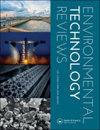Water desalination by forward osmosis: draw solutes and recovery methods – review
Q1 Environmental Science
引用次数: 42
Abstract
ABSTRACT Water production has become a serious concern nowadays due to many environmental and social factors. Conventional desalination processes are considered as energy-intensive, as energy consumption represents 50–60% of water production cost. As an example, multistage flash evaporation (MSF), requires 19.58–27.25 kWhe/m3, and reverse osmosis (RO) 1.5–6 kWhe/m3. Thus, developing forward osmosis (FO), a membrane technology for water desalination considered as a potentially energy-efficient process, has gained growing interest. However, the technology is facing serious limitations concerning the availability of a high-performance draw solution and membrane, which represent the core of the process. In addition to the lack of energy-efficient recoverable draw solutes, as the regeneration process represents the main energy consumption of the overall FO process. In this paper, an updated state of the art of newly developed draw solutes such as deep eutectic solvents, ionic liquids, smart materials, and classical FO draw solutes have been carried out. Finally, FO technology challenges, opportunities, and future prospects have been discussed. Draw solutes have been categorized according to their recovery methods, innovations and draw solutes strengths and limitations have been critically reviewed. The necessity of theoretical energy consumption and water production costs estimation have been outlined, in addition to pilot-scale testing to demonstrate the process feasibility. GRAPHICAL ABSTRACT正渗透海水淡化:提取溶质和回收方法——综述
摘要由于许多环境和社会因素,水生产已成为当今一个备受关注的问题。传统的海水淡化工艺被认为是能源密集型的,因为能源消耗占水生产成本的50-60%。例如,多级闪蒸(MSF)需要19.58–27.25 kWhe/m3和反渗透(RO)1.5–6 因此,开发正渗透(FO),这是一种用于海水淡化的膜技术,被认为是一种潜在的节能工艺,越来越受到人们的关注。然而,该技术在高性能拉伸溶液和薄膜的可用性方面面临着严重的限制,这是该工艺的核心。除了缺乏节能的可回收提取溶液外,因为再生过程代表了整个FO过程的主要能耗。本文介绍了新开发的拉伸溶质的最新技术,如深共晶溶剂、离子液体、智能材料和经典的FO拉伸溶质。最后,讨论了FO技术的挑战、机遇和未来前景。根据回收方法对提取溶液进行了分类,并对创新和提取溶液的优势和局限性进行了批判性回顾。除了中试规模测试以证明工艺可行性外,还概述了理论能耗和水生产成本估算的必要性。图形摘要
本文章由计算机程序翻译,如有差异,请以英文原文为准。
求助全文
约1分钟内获得全文
求助全文
来源期刊

Environmental Technology Reviews
Environmental Science-Water Science and Technology
CiteScore
6.90
自引率
0.00%
发文量
8
 求助内容:
求助内容: 应助结果提醒方式:
应助结果提醒方式:


